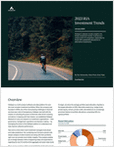The goal of retirement income planning is to convert the client’s nest egg into a stream of inflation-adjusted income that will last the client’s lifetime. This involves 3 major unknowns:
o Investment returns and their pattern by asset class.
o Inflation rates.
o Lifespan (or the planning horizon).
In recent years, several studies have addressed the question of what is a safe withdrawal strategy. These studies generally utilize Monte Carlo analysis or stochastic models to account for variations in investment returns and inflation rates. Most use a fixed lifespan, e.g., 30 years or attained age 95.
The case study described in this article also accounts for variation in the third major unknown–lifespan. This facilitates a more realistic look at the question of whether to insure against longevity risk, or the risk of outliving assets.
The client in this study has a nest egg of $500,000, which was assumed to be 40% invested in equities (24% in large cap, 8% in small cap and 8% in international) and 60% in fixed income (45% in bonds and 15% in money market). Two thousand scenarios were stochastically generated with the following variables year-by-year:
–Investment rates by asset class.
–Inflation rates.
–Mortality rates (based on the Annuity 2000 Mortality Table).
Note that stochastic mortality rates cause the client’s lifespan to vary. In each case, an annual income is withdrawn from the $500,000 nest egg. The income is adjusted annually for inflation and is specific for each scenario. A scenario is deemed successful if inflation-adjusted annual income is maintained over the client’s lifetime. The target success rate was set at 90%, i.e., inflation-adjusted income was fully maintained in 90% of the 2,000 scenarios.
The base case utilizes a systematic withdrawal program (SWP) for the entire $500,000 nest egg. Today, SWPs are the most common method for drawing income from a nest egg. Calculations were done for 6 client variations–male and female; ages 65, 70 and 75 (see Table A). In each variation, the system solves for the initial annual withdrawal amount that meets the 90% target success rate. The table shows both the initial annual withdrawal amount in dollars and as a percentage of the $500,000 nest egg.
Generally, the initial withdrawal rates are in the 4% to 5% range, which coincides with previous studies and current practice recommendations; however, there is some variation by age and gender.








 August 05, 2007 at 04:00 PM
August 05, 2007 at 04:00 PM










